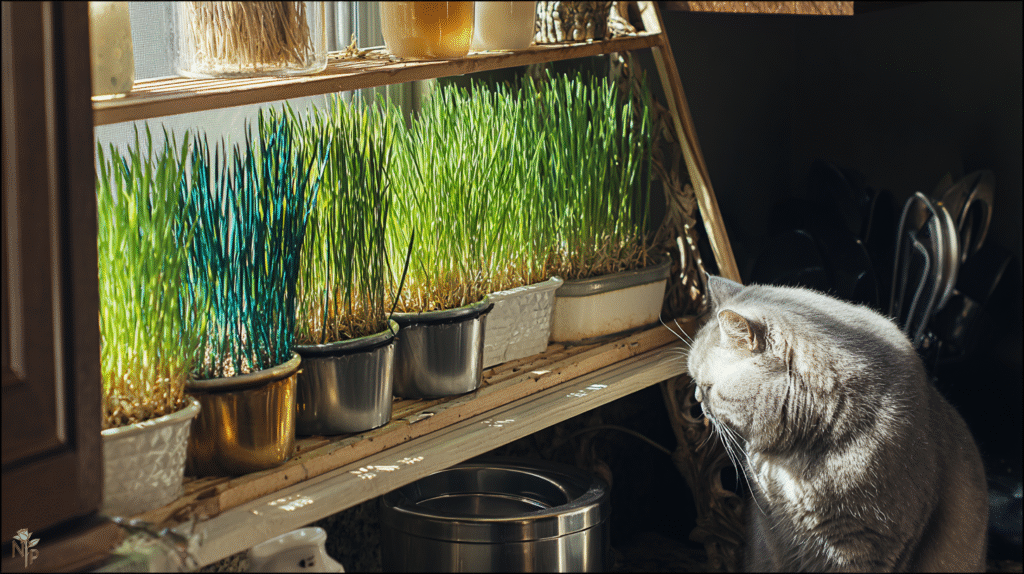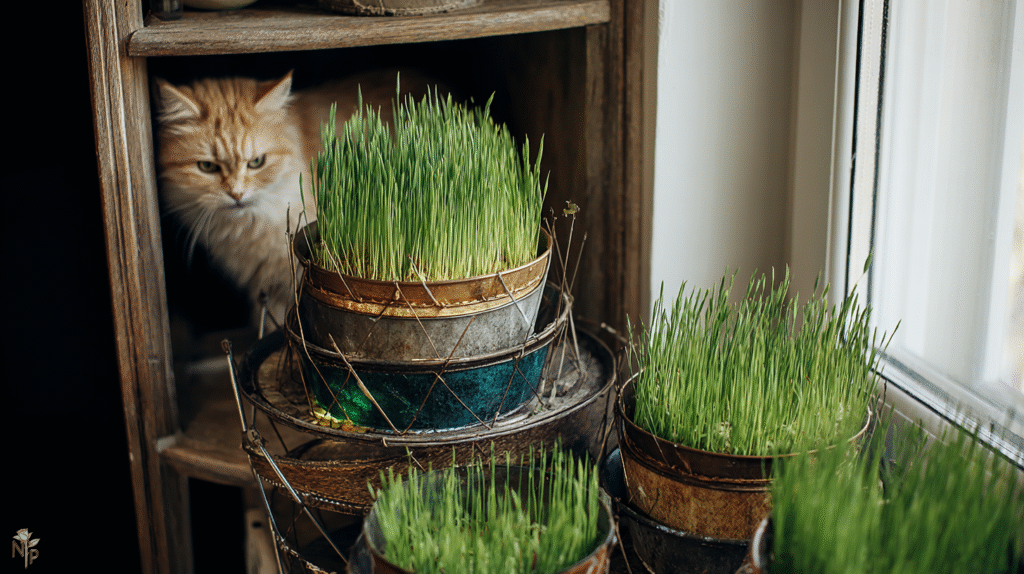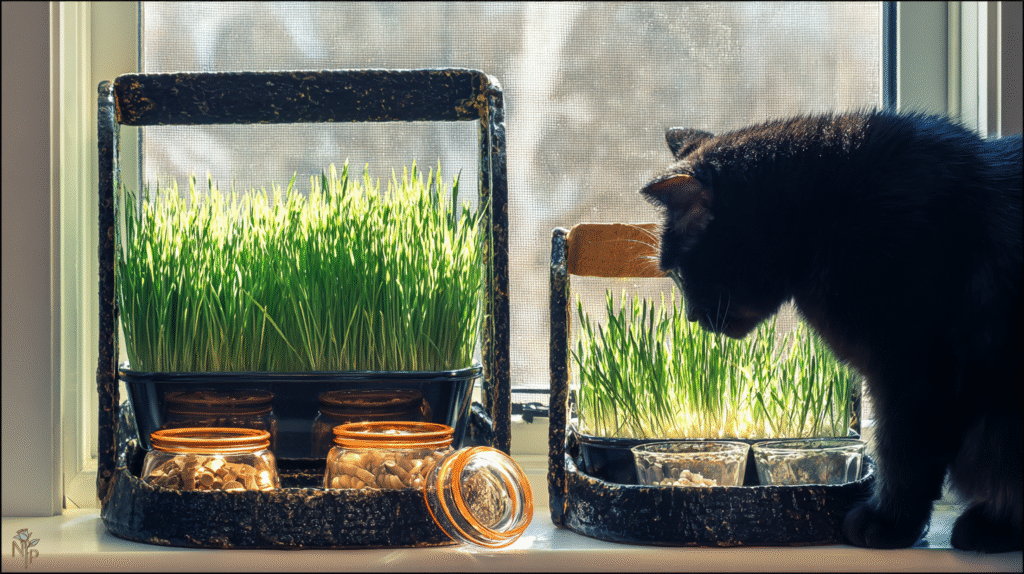My cat Meatball destroyed $200 worth of houseplants before I discovered cat grass. The spider plant? Shredded. The palm? Chomped to stems. That fancy prayer plant from the boutique nursery? Let’s just say it didn’t survive Meatball’s “prayers.”
Then my vet mentioned cat grass. “Just grow some wheat grass,” she said. “Cats love it.” What she didn’t mention was that there are actually different types, and cats have opinions. Strong opinions.
I’ve now grown every type of cat grass available, sometimes having four varieties going at once because apparently I run a feline salad bar. Meatball has preferences. So does his sister Nugget (don’t judge our naming skills). After two years of trial and error, plus roughly 100 batches of various grasses, here are the five varieties that actually work – both for the cats who eat them and the humans who have to grow them.
1. Wheatgrass – The Gateway Grass
This is what everyone thinks of when they hear “cat grass.” It’s also what I started with, and honestly, still my go-to.
Why cats love it: Sweet taste (yes, I’ve tried it – tastes like liquid chlorophyll with sugar). Soft texture that’s easy to chew. Meatball goes absolutely feral for fresh wheatgrass, like catnip-level excitement but with more drooling.
Why you’ll appreciate it: Grows stupid fast. Seriously, planted Monday, cat-ready by Friday. I’ve grown wheatgrass in winter on a dim windowsill and it still worked. Costs pennies when you buy seeds in bulk – I get a pound for $8 online that lasts six months.
The reality check: Only lasts about two weeks before getting woody and gross. Meatball won’t touch it once it’s over 6 inches tall. Also, if you overwater even slightly, it molds faster than bread in a steam room. Lost many batches before figuring out less water is better.
Growing hack: Dense seeding is key. Cover the entire soil surface with seeds touching each other. Looks wrong but creates that thick carpet effect cats love. Sparse planting = sad stringy grass that cats ignore.

2. Oat Grass – The Soft Option
Discovered this when I accidentally bought the wrong seeds. Best mistake ever.
Why cats love it: Softer than wheatgrass, wider blades, easier on sensitive mouths. Nugget has some missing teeth (street cat past) and oat grass is the only type she can properly chew. Meatball treats it like grass bubble gum – chews it forever then spits it out.
Why you’ll appreciate it: Slightly slower growing than wheat (7-10 days) but lasts longer – up to three weeks before getting tough. Doesn’t get as tall, so less likely to flop over and make a mess. Also seems more mold-resistant, probably because it doesn’t need as much water.
The reality check: Seeds are more expensive and harder to find. Local stores rarely carry them. I order online, about $12 per pound. Also, some cats just… don’t care about it. My friend’s cat took one sniff and walked away. Meatball only eats it when the wheatgrass runs out.
Growing hack: Mix with wheatgrass seeds 50/50. Gives variety in texture and extends the harvest window since they mature at different rates. Plus if your cat decides they hate oat grass, you haven’t wasted a whole pot.
3. Barley Grass – The Robust Choice
This one surprised me. Tougher than the others but in a good way.
Why cats love it: More texture for cats who like to really work for their greens. Meatball attacks barley grass like it owes him money. Something about the slightly rougher texture triggers his hunting instincts. Entertainment value plus nutrition.
Why you’ll appreciate it: Takes more abuse than other grasses. Meatball can chomp half of it down and it keeps growing. Wheatgrass gives up after one aggressive eating session. Barley just keeps coming back. Also stays green longer – up to a month if you don’t overwater.
The reality check: Takes longer to grow (10-14 days) and never gets as lush as wheatgrass. Some cats find it too tough. Nugget tries but usually gives up and goes for softer options. Also, the seeds are weirdly expensive at pet stores ($15 for 4 ounces) but cheap at brewing supply stores ($5 per pound – same seeds, different packaging).
Growing hack: Soak seeds overnight before planting. Speeds up germination by 3-4 days. Learned this from a homebrewing forum, of all places.
4. Rye Grass – The Reliable Backup
Nobody talks about rye but it’s secretly the best for lazy gardeners (me).
Why cats love it: Similar to wheatgrass but slightly different taste. Meatball prefers wheat, but when that’s gone, rye is acceptable. It’s like the store-brand cereal of cat grass – not the favorite but totally fine.
Why you’ll appreciate it: Grows in anything, anywhere, anytime. I’ve grown rye grass in 40°F weather on my porch. In pure sand. Forgot to water it for five days once – still grew. It’s the cockroach of cat grasses. If you kill everything else, try rye.
The reality check: Not as nutritious as wheat or barley. Faster to get stringy and tough. Cats seem less excited about it. It’s nobody’s first choice but everyone’s backup plan.
Growing hack: Great for mixing with other seeds to bulk up your grass and make expensive seeds go further. I do 25% rye in all my mixes now. Adds volume without anyone noticing.

5. The Ultimate Mix – Because Cats Are Bougie
After a year of growing single varieties, I started mixing. Game-changer.
My perfected mix:
- 40% wheatgrass (fast growth, sweet taste)
- 30% oat grass (soft texture)
- 20% barley grass (longevity)
- 10% rye grass (filler and backup)
Why cats love it: Variety in texture and taste. Different heights create interest. Meatball grazes like he’s at a buffet, sampling each type. Nugget can find the soft parts she prefers. Something for everyone.
Why you’ll appreciate it: Extended harvest window – as wheat peters out, barley takes over. More forgiving of watering mistakes since different grasses have different needs. Looks fuller and more “professional” than single varieties. People think I’m some kind of cat grass expert when really I’m just mixing seeds.
The reality check: Have to buy multiple seed types. Initial investment around $35 for all seeds, but lasts literally months. Math works out to about $2 per pot of grass that lasts 2-3 weeks.
Growing Setup That Actually Works
Container: Shallow is key. I use aluminum baking pans from the dollar store or old takeout containers. Drainage holes are optional if you’re careful with water. Depth of 2 inches is plenty.
Soil: Regular potting soil works but I’ve had better luck going soilless. Paper towels or coconut coir. Sounds weird but no mold issues and easier cleanup when it’s done.
Location: Any window works. I grow mine on the kitchen counter under the cabinets – not even by a window. The under-cabinet lights are enough. These grasses are not picky about light.
Watering: Mist don’t pour. Keep moist not soaked. I water every 2-3 days with a spray bottle. The number one killer of cat grass is overwatering leading to mold.
The Rotation System
I keep three containers going at all times:
- Week 1: Just planted
- Week 2: Ready to eat
- Week 3: Getting eaten/getting old
Start a new container weekly, toss the oldest. Constant supply, no gaps, happy cats.

Why Bother?
Since starting the cat grass operation, Meatball hasn’t touched a houseplant. My plants are thriving. He yarfs up hairballs less (the fiber helps). Nugget seems happier having something she can actually chew. And honestly? Watching them graze like tiny cows is endlessly entertaining.
Plus, it costs maybe $8 a month to keep both cats in constant grass. That’s less than one destroyed houseplant. The math is simple.
Just remember: cats have preferences. Start with wheatgrass, experiment from there. And when you find what your cat loves, buy seeds in bulk. You’ll be growing a lot of it. Trust me, once they get a taste for the good stuff, they’ll demand their salad bar stays stocked.






